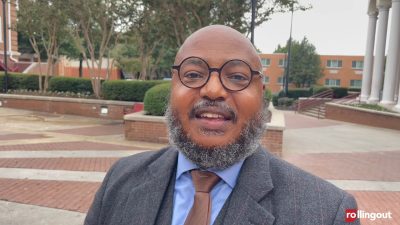 Morehouse College Economics Professor John Handy blew back the packed crowd inside the Shirley Massey Auditorium at the famed college when he surgically dissected the social and economic impact of education — more specifically higher education — versus the cost and ramifications of growing rate of high school dropouts, particularly as it pertains to young black men.
Morehouse College Economics Professor John Handy blew back the packed crowd inside the Shirley Massey Auditorium at the famed college when he surgically dissected the social and economic impact of education — more specifically higher education — versus the cost and ramifications of growing rate of high school dropouts, particularly as it pertains to young black men.
Most of us know by now the direct correlation between education levels and the levels of criminality existing in a particular family, neighborhood, community and city. But few have broken it down the way Dr. Handy did during the “Black Male Summit.”
Take a look at what Dr. Handy had to say:
We do know that more education means lower unemployment, lower rates of poverty and less reliance on social programs,
College grads have lower smoking rates, better health habits.
We know that when we estimate the social savings from lower incarcerations, and higher rates of civic engagement and volunteer work.
Higher income people tend to have their children in college more. The top 20 percentile see their children go to college at a 82 percent of their children go to college, compared to 50 percent clip of the lower 20 percentile.
Educated women are found to have improved infant health, birth rate and gestational age, improvements in marriage rates, reduction in smoking.
Accoding to a Harvard Study in 2003 found that in 2002 that the U.S. prisons spent about $26,000 a year per prisoner while colleges spend about $25,000 a year per student.
In 1980, 53 percent of black inmates had less than a high school education. By 2008, 62 percent of black inmates had less than a high school education. Today, 2 out of every 3 inmate had less than a high school education. Only 6 percent of inmates had some college education. So, incarceration rates fall dramatically as higher education increases.
The average education level (for all Americans) in 1940 was eight years of education. Only 36 percent of people graduated from high school then.
“What happened? Post World War II, we had a revolution in education,” he said. “And a revolution in productivity in the United States.”
When you have a neighborhood or community where you have more college grads, it creates an environment where more people want to attend and graduate from college.
Level of productivity:
We know that looking at that data. If I take 1990 as a base year and use that as 100, when you go to 1940, using output per hour, you only had 16 percent productivity of what it would be in 1990. It increased to 55 percent in 1960, 86 percent by 1980 and 118 percent by 2000. Education went up. High school graduation went from 36 percent in 1940 to 86 percent in 2000.
So it’s not surprising that when America pulled ahead of the rest of the world after World War II in terms of income, it was quick to pull ahead in terms of income.
In 1968, Columbia University asked what is the impact of education on productivity and the rest of society? So there are three important characteristics of education:
- Knowledge is expandable and self-generating. Knowledge increases the more we use it. Knowledge does not wear out; it only expands.
- Knowledge is substitutable — how we got the green revolution, how we can transform agriculture.
- Knowledge is transportable. We can now move at the speed of light.
And perhaps the most important statistic that Dr. Handy delivered:
Studies have concluded that ability gaps are determined very early in life that not only affect cognitive skills, but also social and emotional skills, physical health, mental health, perseverance, motivation, attention and self confidence that expands cognitive development.
Therefore, early childhood education has a higher return on investment than any other investment in the world.
Let me repeat: The studies have concluded that investment in early childhood education, 0 to 5, gives a higher level of return in lifetime income than in any investment we know. This has been proven conclusively. If you don’t get them early, it becomes more and more expensive.
















